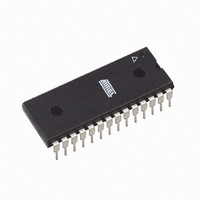ATMEGA48A-PU Atmel, ATMEGA48A-PU Datasheet - Page 116

ATMEGA48A-PU
Manufacturer Part Number
ATMEGA48A-PU
Description
IC MCU AVR 4K FLASH 28PDIP
Manufacturer
Atmel
Series
AVR® ATmegar
Specifications of ATMEGA48A-PU
Core Processor
AVR
Core Size
8-Bit
Speed
20MHz
Connectivity
I²C, SPI, UART/USART
Peripherals
Brown-out Detect/Reset, POR, PWM, WDT
Number Of I /o
23
Program Memory Size
4KB (2K x 16)
Program Memory Type
FLASH
Eeprom Size
256 x 8
Ram Size
512 x 8
Voltage - Supply (vcc/vdd)
1.8 V ~ 5.5 V
Data Converters
A/D 6x10b
Oscillator Type
Internal
Operating Temperature
-40°C ~ 85°C
Package / Case
28-DIP (0.300", 7.62mm)
Controller Family/series
Atmega
No. Of I/o's
23
Eeprom Memory Size
256Byte
Ram Memory Size
512Byte
Cpu Speed
20MHz
Rohs Compliant
Yes
Lead Free Status / RoHS Status
Lead free / RoHS Compliant
- Current page: 116 of 566
- Download datasheet (23Mb)
15.2.2
15.3
8271C–AVR–08/10
Accessing 16-bit Registers
Definitions
put Compare Units” on page
Flag (OCF1A/B) which can be used to generate an Output Compare interrupt request.
The Input Capture Register can capture the Timer/Counter value at a given external (edge trig-
gered) event on either the Input Capture pin (ICP1) or on the Analog Comparator pins (See
”Analog Comparator” on page
Canceler) for reducing the chance of capturing noise spikes.
The TOP value, or maximum Timer/Counter value, can in some modes of operation be defined
by either the OCR1A Register, the ICR1 Register, or by a set of fixed values. When using
OCR1A as TOP value in a PWM mode, the OCR1A Register can not be used for generating a
PWM output. However, the TOP value will in this case be double buffered allowing the TOP
value to be changed in run time. If a fixed TOP value is required, the ICR1 Register can be used
as an alternative, freeing the OCR1A to be used as PWM output.
The following definitions are used extensively throughout the section:
The TCNT1, OCR1A/B, and ICR1 are 16-bit registers that can be accessed by the AVR CPU via
the 8-bit data bus. The 16-bit register must be byte accessed using two read or write operations.
Each 16-bit timer has a single 8-bit register for temporary storing of the high byte of the 16-bit
access. The same temporary register is shared between all 16-bit registers within each 16-bit
timer. Accessing the low byte triggers the 16-bit read or write operation. When the low byte of a
16-bit register is written by the CPU, the high byte stored in the temporary register, and the low
byte written are both copied into the 16-bit register in the same clock cycle. When the low byte of
a 16-bit register is read by the CPU, the high byte of the 16-bit register is copied into the tempo-
rary register in the same clock cycle as the low byte is read.
Not all 16-bit accesses uses the temporary register for the high byte. Reading the OCR1A/B 16-
bit registers does not involve using the temporary register.
To do a 16-bit write, the high byte must be written before the low byte. For a 16-bit read, the low
byte must be read before the high byte.
The following code examples show how to access the 16-bit Timer Registers assuming that no
interrupts updates the temporary register. The same principle can be used directly for accessing
the OCR1A/B and ICR1 Registers. Note that when using “C”, the compiler handles the 16-bit
access.
ATmega48A/48PA/88A/88PA/168A/168PA/328/328
BOTTOM
MAX
TOP
The counter reaches the BOTTOM when it becomes 0x0000.
The counter reaches its MAXimum when it becomes 0xFFFF (decimal 65535).
The counter reaches the TOP when it becomes equal to the highest value in the count
sequence. The TOP value can be assigned to be one of the fixed values: 0x00FF, 0x01FF,
or 0x03FF, or to the value stored in the OCR1A or ICR1 Register. The assignment is
dependent of the mode of operation.
123. The compare match event will also set the Compare Match
247) The Input Capture unit includes a digital filtering unit (Noise
116
Related parts for ATMEGA48A-PU
Image
Part Number
Description
Manufacturer
Datasheet
Request
R

Part Number:
Description:
IC AVR MCU 4K 5V 20MHZ 32-TQFP
Manufacturer:
Atmel
Datasheet:

Part Number:
Description:
Manufacturer:
Atmel Corporation
Datasheet:

Part Number:
Description:
Manufacturer:
Atmel Corporation
Datasheet:

Part Number:
Description:
IC AVR MCU 4K 20MHZ 5V 32TQFP
Manufacturer:
Atmel
Datasheet:

Part Number:
Description:
IC AVR MCU 4K 20MHZ 5V 28DIP
Manufacturer:
Atmel
Datasheet:

Part Number:
Description:
IC AVR MCU 4K 20MHZ 5V 32-QFN
Manufacturer:
Atmel
Datasheet:

Part Number:
Description:
IC AVR MCU 4K 5V 20MHZ 32-TQFP
Manufacturer:
Atmel
Datasheet:

Part Number:
Description:
IC AVR MCU 4K 5V 20MHZ 32-QFN
Manufacturer:
Atmel
Datasheet:

Part Number:
Description:
IC AVR MCU 4K 5V 20MHZ 32-QFN
Manufacturer:
Atmel
Datasheet:

Part Number:
Description:
IC AVR MCU 4K 5V 20MHZ 28-DIP
Manufacturer:
Atmel
Datasheet:

Part Number:
Description:
IC AVR MCU 4K 5V 20MHZ 28-DIP
Manufacturer:
Atmel
Datasheet:

Part Number:
Description:
IC AVR MCU 4K FLASH 20MHZ 28QFN
Manufacturer:
Atmel
Datasheet:











